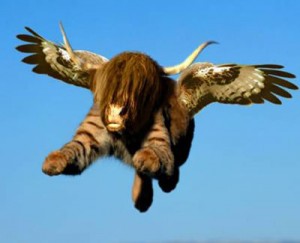
Throughout 2011, the Australian economics fraternity, media and the community more broadly have been under sustained assault from above. The attack came not from magpies in heat, nor a swarm of killer bees, but from a hitherto unknown creature, the bullhawk.
The bullhawk is an occult animal that juxtaposes incompatibles. It is half interest rate hawk and half housing bull and from its great eyrie amongst the glassy peaks of Sydney’s CBD, it swooped upon an unsuspecting public and struck the fear of God into them about a thousand year run of interest rate hikes.
The public ran screaming for shelter. Yet some business commentators were mesmerised by the bullhawk’s razor sharp beaks, their magnificent plumage and their wild cries for rate hikes. These unfortunate souls clambered up the glittering slopes and joined the flerd (flock + herd) where, for a moment, they surveyed their new domain. And, like baby bullhawks, they joined the shrill cry for rate rises.
But, once in the eyrie, the full horror of their situation dawned. They were consumed, torn to shreds by their own audacity, as the rate hike hysteria that echoed from the glittering mountain top died in the high atmospheres, far from earth.
Paul Bloxham of HSBC was one the bullhawks. By no means was he a leading fowl, but his housing bullishness, proclaimed so boldly in the early months of 2011 merged into a consistent rate hawkishness throughout 2011. To his credit, as the year wore on, he moderated his cries and, in the past few weeks he has, along with many other banks, taken to a new thermal, incrementally peeling from the bullhawkian flerd. He also went some way to redeeming himself in my eyes with his excellent report on Dutch disease.
And today, Bloxham has swept further from the flerd with a new note:
A cold we can deal with, but pneumonia is another thing altogether. As we have highlighted recently, Australia is not entirely immune to the global woes (see Asian Economics Quarterly: Will Asia Crack, 6 October). This month’s confidence, employment and CPI indicators will be critical for assessing the level of immunity and the RBA’s next move.
Recall that in early August the RBA was on the cusp of raising interest rates to deal with Australia’s prospective inflation problems. Faced with a mining boom, weak productivity growth and rising inflation the RBA had been hawkish all year. Things have changed.
This week the RBA have given us their first signal that they would now consider moving rates in the other direction. The intense period of financial market volatility over the past couple of months – with as yet no definitive resolution – is the clear catalyst. As we have been saying for some time, in order to cut rates the RBA would need to credibly revise down underlying inflation forecasts (published in early August) from above the target band, at 3.25%, to the lower half of the target band, below 2.50%.
This is a high hurdle. But the longer financial market volatility persists, the more it grinds down confidence, and the more likely it is that economic activity slows and inflation comes down. RBA rhetoric has shifted from concern about the ‘medium-term outlook for inflation’ to suggesting ‘the path for inflation may now be more consistent with the 2–3 per cent target in 2012 and 2013’. But more evidence is needed to see outright cuts.
Key indicators to watch will be the labour market survey for September, out next week, and 3Q CPI, due on 26 October. Confidence surveys out next week are also important. A rise in the unemployment rate from its current 5.3% to 5.5% (or higher) would open the door for a rate cut. Combine it with a reading on the trimmed mean inflation measure that was in, or below, the target band and we could see the RBA willing to pull the trigger.
Neither is our central forecast, so we still see the RBA on hold this year. We expect unemployment to be broadly steady and underlying inflation to print above the band. But these data are notoriously hard to forecast and critical indicators for the RBA’s next move.
I will note in passing that Bloxham has it backwards. Confidence has been rising since August, as it became clear that the RBA was steadfastly ignoring the screetching of the bullhawks. Sure, it will no doubt fall again if the global economy slows as I expect it to into next year. But let’s give credit where it’s due.
As an avid ornothologist I must also note that with Bloxham’s departure from the flerd, only two bullhawks now soar above. That is as it should be, they were always the mightiest of the creatures. ‘Mad’ Adam Carr and the Lord of the Bullhawks himself, Chris Joye, have barely altered course. Stretched from pinion to pinion, the two now circle above, hooves akimbo, feathered heads outstretched, beaks dripping and eyes trained far below, seeking the small darting creature, inflation, their elusive prey.

